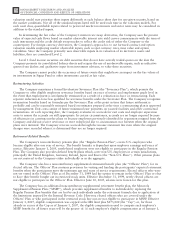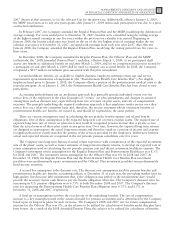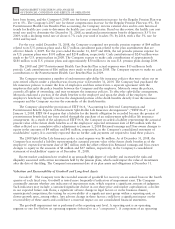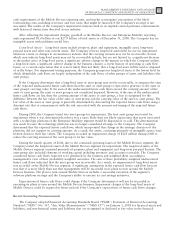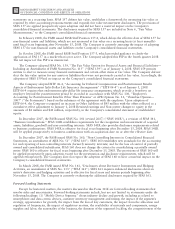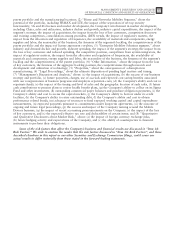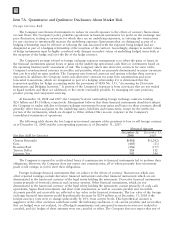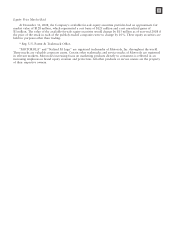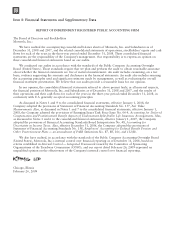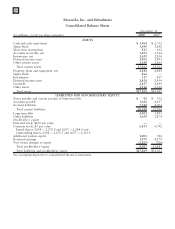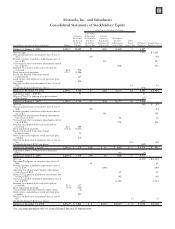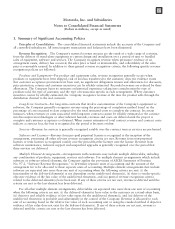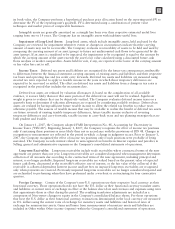Motorola 2008 Annual Report Download - page 87
Download and view the complete annual report
Please find page 87 of the 2008 Motorola annual report below. You can navigate through the pages in the report by either clicking on the pages listed below, or by using the keyword search tool below to find specific information within the annual report.
these conditions will occur. The Company expects that gains and losses on the derivative financial instruments
should offset gains and losses on the assets, liabilities and future transactions being hedged. If the hedged
transactions were included in the sensitivity analysis, the hypothetical change in fair value would be immaterial.
The foreign exchange financial instruments are held for purposes other than trading.
The ineffective portion of changes in the fair value of foreign currency fair value hedge positions for the
periods presented were de minimis. These amounts are included in Other within Other income (expense) in the
Company’s consolidated statements of operations. The above amounts include the change in the fair value of
derivative contracts related to the changes in the difference between the spot price and the forward price. These
amounts are excluded from the measure of effectiveness. Expense (income) related to fair value hedges that were
discontinued for the years ended December 31, 2008, 2007 and 2006 are included in the amounts noted above.
The Company recorded income (expense) of $(2) million, $1 million and $13 million for the years ended
December 31, 2008, 2007 and 2006, respectively, representing the ineffective portions of changes in the fair value
of cash flow hedge positions. These amounts are included in Other within Other income (expense) in the
Company’s consolidated statements of operations. The above amounts include the change in the fair value of
derivative contracts related to the changes in the difference between the spot price and the forward price. These
amounts are excluded from the measure of effectiveness. Expense (income) related to cash flow hedges that were
discontinued for the years ended December 31, 2008, 2007 and 2006 are included in the amounts noted above.
During the years ended December 31, 2008, 2007 and 2006, on a pre-tax basis, income (expense) of
$3 million, $(16) million and $(98) million, respectively, was reclassified from equity to earnings in the Company’s
consolidated statements of operations.
At December 31, 2008, the maximum term of derivative instruments that hedge forecasted transactions was
one year. The weighted average duration of the Company’s derivative instruments that hedge forecasted
transactions was seven months.
Interest Rate Risk
At December 31, 2008, the Company’s short-term debt consisted primarily of $89 million of short-term
variable rate foreign debt. The Company has $4.1 billion of long-term debt, including the current portion of long-
term debt, which is primarily priced at long-term, fixed interest rates.
As part of its liability management program, the Company historically entered into interest rate swaps
(“Hedging Agreements”) to synthetically modify the characteristics of interest rate payments for certain of its
outstanding long-term debt from fixed-rate payments to short-term variable rate payments. During the fourth
quarter of 2008, the Company terminated all of its Hedging Agreements. The termination of the Hedging
Agreements resulted in cash proceeds of approximately $158 million and a gain of approximately $173 million,
which has been deferred and will be recognized as a reduction of interest expense over the remaining term of the
associated debt.
Prior to the termination of the Hedging Agreements in the fourth quarter of 2008, the Hedging Agreements
were designated as part of fair value hedging relationships of the Company’s long-term debt. As such, the changes
in fair value of the Hedging Agreements and corresponding adjustments to the carrying amount of the debt were
recognized in earnings. Interest expense on the debt was adjusted to include payments made or received under such
Hedging Agreements. During 2008 (prior to the Hedging Agreements being terminated) and 2007, the Company
recognized expense of $1 million and $2 million, respectively, representing the ineffective portion of changes in the
fair value of the Hedging Agreements. These amounts are included in Other within Other income (expense) in the
Company’s consolidated statement of operations.
Certain of the terminated Hedging Agreements were originally entered into during the fourth quarter of 2007.
The Company entered into the Hedging Agreements concurrently with issuance of long-term debt to convert the
fixed rate interest cost on the newly issued debt to a floating rate. The Hedging Agreements were originally
designated as fair value hedges of the underlying debt, including the Company’s credit spread. During the first
quarter of 2008, the swaps were no longer considered effective hedges because of the volatility in the price of the
Company’s fixed-rate domestic term debt and the swaps were dedesignated. In the same period, the Company was
able to redesignate the same Hedging Agreements as fair value hedges of the underlying debt, exclusive of the
Company’s credit spread. For the period of time that the Hedging Agreements were deemed ineffective hedges, the
Company recognized a gain of $24 million in the Company’s consolidated statements of operations, representing
the increase in the fair value of the Hedging Agreements.
79



